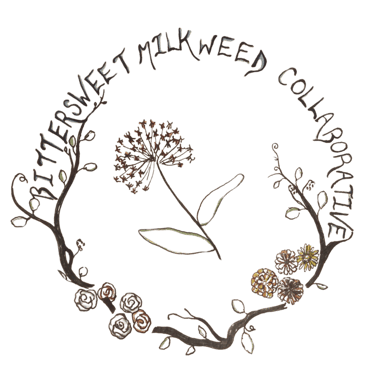October Is A Golden Month
Gathering the Good During a Year of Changes
Kia-Beth Bennett
10/21/202512 min read
It’s taken me a long time to find a way to describe how I feel about the weather this Autumn: in a USDA Zone 4, we’re experiencing averages of 70 degrees Fahrenheit while undergoing a 100-year drought. Despite my best efforts, the cows’ streaming eyes speak volumes about the waves of dust blowing up from the pastures. I feed them the Winter’s hay supply while wearing shorts and a tank-top. Yet I frequently run into folks who insist upon cheerfully exclaiming, “Beautiful day, isn’t it?”
For years, I’ve struggled to answer that question. When I inevitably succumb to my reality and answer honestly about whatever cataclysmic weather I’ve witnessed, I hear some version of, “Well, I can see how it’s hard for you farmers (not my emphasis).” Two weeks ago, when faced with said question, I replied that though I was grateful I could work comfortably outside, I was (am) incredibly concerned about the drought. The man initiating the conversation - a Canadian from Brockville - asked, without a trace of irony, “Now, why do you think that [the drought] is [happening]?”
Sir. In the past five years your nation’s forest fires have brought life-threatening levels of ash on the local airways. You tell me what the fuck the problem is.
The answer, of course, is human-caused, industry-fueled climate change. That it’s not on everyone’s minds every second of every day completely and utterly floors me. I understand that that is a privileged view, but I truly did not know it was possible to live without a constant stream of climate anxiety and micro-ecosystem solutions swimming in one’s blood. But here we are. North Country farms are parched, farms in Texas have washed away, and more people don’t get it than do, so this is how I'm articulating my experiences:
So much of this month has been visually stunning - the golden glow of the leaves and enormous, bright sky is amazing. I take pictures and dream of painting the hues I’m in awe of. While convalescing in bed with COVID last week, one of my favorite activities was admiring and listening to the maples, apples and walnuts outside my window, watching nuthatches, chickadees and squirrels scramble through the branches. I’m making friends with the chipmunk who lives amongst the young box-elders, and today’s rains find me desperately thanking every deity and spirit around.
And:
Trying to appreciate and live in the moment of this year’s Autumnal beauty is a lot like spending time with a loved one undergoing chemotherapy for Stage Four cancer. There are moments of beauty, laughter, warm breezes and good memories. There are times to cherish and exist in joy. Simultaneously, with the same weight, there is the menacing, powerful shadow that is both the disease and the treatment. The laughter does not stop the vomiting, the wasting away, the inability of your loved one to eat, or sleep, or walk without pain. The beauty stands alongside the omnipresent knowledge that today may be the last time they can see, or speak, or go to your house for a visit. Everywhere you look, you glimpse a future without them, and know that you must learn to navigate that, even as it’s occurring. You did not cause the problem, but it is now your responsibility, fear, and life. There is no other way but forward and through, and someone will die along the way.
That’s what it’s like. I can admire those golden leaves until they disintegrate, but my every moment is filled with thoughts of drought, soil compaction, overgrazing, insufficient snowload, late frosts, plant-based nutrient density, disease overload, insect incursions, seed production and release, breeding schedules, predator needs, cold and heat tolerance, and parasites - and that is a short list of just the Autumn and Winter concerns. So honestly? No, it’s not a beautiful day. The sky is beautiful, the plants are beautiful, the animals are beautiful, and it is a day. But I’m always going to see the bigger picture, which is that, in the middle of a hundred-year drought, we are metaphorically drowning.
Well. That was, compared to every other newsletter, pretty short, and I’m not going to leave you all there. But, like I mentioned, I have COVID and brain fog and so don’t really give a crap about anything right now. You'll have to wait until November for descriptions of how we're surviving the climate crisis. You will instead, this month, be treated to an extremely rare, much-sought-after, difficult-to-find description of pure positivity regarding the BMC, by yours truly. Congratulations!
But Kia! You may exclaim. But Kia! Wherever will I get my tales of hypothermic piglets, selenium-deficient rams and infuriating classism? Who else writes with such candor about destroyed gardens, empty bank accounts and dying cows??
I know, I know. There are actually very few people willing to discuss the nuances of stomach worms in ewes and their subsequent health crises. You’re just gonna have to put up with it, I suppose. I completely understand if two-thirds of a newsletter being filled with cheer is too much for you. You are welcome to leave, stock up on genocides and fascism elsewhere, and come back next month. I understand, I really do.
However, for those of you seeking, or attempting to swallow, something you can smile about, there’s a lot on the farm to be proud of this year. In no particular order, here is an incomplete list:
The last batch of chicks was raised in the open-air processing shed, rather than the farm office. This reduced dust in the office, and gave the chicks the opportunity to verbally interact with the free-roaming adults, improving their mental well-being, education and growth. They were far better equipped to move outside, and they formed bonds with certain roosters and hens in ways I’d never before seen.
We successfully raised six bottle-baby piglets to weaning, despite having never raised even one bottle pig to weaning. I learned a lot about colostrum, E.coli and garlic while I was at it.
Our carrion beetle population skyrocketed again, demonstrated by the astounding number of adults and larvae feeding on Elmer the bull’s skull this Spring.
Our young apple trees produced full-size apples!! They’re still hanging on the trees, as they are late-season and hard as rocks right now. Despite the wet Spring, we also harvested a good number of pears.
The first killing frost hit before the late blight, saving the potatoes and tomatoes from said disease. Thank goodness.
My fig tree is now too big to comfortably fit in the bathroom. They need a bigger pot and a better window, and I need to learn to prune them before they hit seven feet tall. Our houseplant population is collectively reaching the triple digits and includes trees, vines, geraniums, spider plants, succulents and fuchsias.
I’ve now traded beef with our neighbor for two truckloads of premium firewood - never done that before!
I made two large batches of salsa again: classic mild and green tomato. I particularly love the green tomato.
We’re still enjoying last year’s relish, which Brian raved about last week as I reminded him it was, in fact, made with unripe pumpkins instead of cucumbers, as we didn’t have a cucumber harvest. We also still have plenty of catsup, tornado sauce, and dried tomatoes.
We formed the Farm Committee, a group of advisors who meet with me via video-call once a month. They provide encouragement, suggestions, ideas and listen as I walk through what the next steps here are.
I butchered my first sheep, eviscerating them between animal care and skinning them in the Solarium. Emily came North again and taught me about how to cut them up.
I butchered my first pig. She weighed way more than I anticipated, and by ‘butchered’ I mean ‘skinned, quartered and stuffed in a freezer’, but hey! She’s dead, she’s eviscerated, and someday she’ll be bacon. That was an interesting birthday night.
Speaking of birthdays, I managed to, for the second year in a row, travel to Sand River Community Farm for mine. I stopped and visited Ravenwood Herbals, spent time planting potatoes (not what I’d planned, but Adam asked…) ate great food and met great people. The farm here was graced with seven volunteers who helped Brian while I was absent.
Student-led groups have volunteered at the farm every available weekend this and last semester, participating in tasks that range from cement work to light carpentry to potato harvesting.
The sheep are now well-trained and eager to follow a bucket, move to new pasture, and take appropriate shelter at the end of the day. They wait patiently for me at the gate and are extremely communicative about their needs. This has been years in the making; previously, the sheep very much existed on their own in Spring and Summer, only interacting with humans during lambing season. Nowadays, though they are still reasonably skittish, the level of trust we have in each other is mind-blowing, and it creates a better farm environment for everyone.
Carly and I were able to rescue the peppermint and orangemint from being choked out by weeds in the garden, and they are growing nicely in Greenhouse #2. The parsley, chives and tarragon are also doing splendidly, and the sage and wormwood are recovering from a rough time last year.
The katydid population at my house was just incredible. Katydids kept me awake at night, crawled into the house, stuck to the porch screen and more. I was thrilled and can’t wait for the next boom cycle.
I met my second ever rove beetle this month, having met my first last Summer. The rove beetles around here are long, gray creatures with gold, sparkly tails who live in the piles of cow manure.
We now have 381 subscribers to this blog, with 12 of them paid, and we’re grossing $582 annually from those amazing folks. I mentioned last month that that covers two months’ mortgage payments each year.
Despite the drought, the phlox at my house clung to life, and their prolific blossoms provided the many, many, many sphinx moths and many hummingbirds nectar late into the season, nourishing those tiny flyers before migration.
I saw my first snowberry clearwing sphinx moth. I’m not making that name up, click the link. It was so cool. I also assisted two newly-metamorphosed white-lined sphinxes, and found two luna moth chrysalides. I’m a fan of moths.
The American toads from last year survived the Winter, and have been traveling around the farm a lot in the past month or so.
Our blue-spotted salamander population has grown enough that I watched them migrate across the road in Spring.
Our red-bellied and milk snake populations both increased.
Looks like we’re a serious stopover for migrating tree swallows. Last year I counted three separate flocks coming through; this year there were five. We’re also now a stopover for white-crowned sparrows and spotted sandpipers.
A Blandings turtle momma tried to nest in Greenhouse #2. Unfortunately, I walked in as she was digging and she left, but that was actually probably good, as it got too hot in there for her eggs. I hope she found a safe location elsewhere on the farm and that the kids are alright.
After over a decade of uncertainty, we recorded new proof of black-billed cuckoo birds living in the farm forests. I think we can hesitantly say we’re hearing grouse again, too, and we once more recorded savannah sparrows, rusty blackbirds and golden-winged warblers.
We expanded the third Little Farm Library, tripling the number of books we’re able to offer to neighbors. Traffic has increased and I’ve been sorting through what we have left to ensure we’re stocked with our patrons’ favorites. If anyone has books in need of a home, we’d be happy to add them to our shelves. Children, young adult, Amish fiction, and farming books are the most popular.
It was a mast year for the black walnuts, and several bushels of them are drying in Greenhouse #1 for Winter use. They’ll be eaten, shared with the pigs, and the husks used as a vermifuge.
The garlic harvest was wonderful, and we successfully added a new variety, Georgian Fire, to the mix. Many thanks to Campus Kitchens, who performed the bulk of the digging.
The Snuggle Tunnel and Summer Dacha - buildings where pigs, sheep, cows and chickens live at various times - both saw a continuation of their construction. They remain unfinished, but anyone with a little carpentry experience is welcome to assist in nailing on the siding and screwing on the roof.
I was again able to attend the littleGrasse Community Farm Annual Swap. Folks from around the area spend a wonderful afternoon visiting, sharing and trading what each of us have made or grown throughout the year. It was something my mother and I made sure to always attend, and I’m glad I didn’t miss it.
(Photo below: A staircase view of the Swap at littleGrasse Community Farm. Photo credit to littleGrasse Community Farm.)

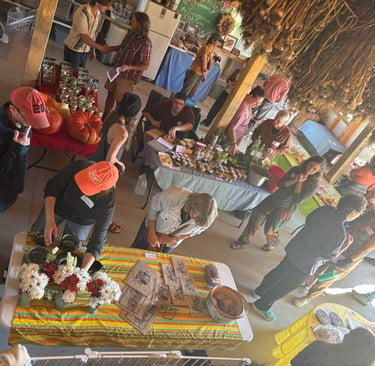
We had a lovely visit with our relatives John and Kathy, who traveled East from Indiana. I’d not seen them since I was...eight? and we were able to wander the farm, take pictures and catch up. Thank you to them both for the wonderful gifts they left with us.
For the first time since the start of Bittersweet Farm, the pig sounder was able to harvest and eat acorns from our five-tree oak “forest”. They adored them, and I am ecstatic to see that very long-term project really begin to blossom.
Someone pulled up to the farm last week and asked if we needed any rain barrels. We managed to purchase over a dozen secondhand, food-grade, plastic barrels to put under every roofline, and we’re collecting rainwater as I type.
If even half the chickens continue to lay sporadically this Winter, we will have enough eggs. The birds are so healthy and even the pullets are laying quite prolifically.
For two months this Summer, the Dexter cattle, the ewes and four sows all grazed, relaxed and lived together in the Oak Pasture, an example of multi-species existence I’ve been working towards for years.
I was forced into scaling back, recognizing my limitations and generally establishing new guidelines for farm ‘production’. It’s been an excruciating process, and there is still a laundry list of things to do to create positive change around here, but it was a much-needed push into a more sustainable way of life for myself, Brian and the farm.
We had a white heifer calf. A white heifer, y’all - we have no white adults; she took us completely by surprise. Her name is Senna, she’s growing at an unprecedented rate, and she shows clear signs of becoming the matriarch of the herd once Galadryal steps down. She’s great with the younger calves and incredibly attentive to safety and family.
All of this year’s calves are great, really. There’s Senna, Peanut Butter (I call him Hayweather), Estrella and Chicory. Estrella and Chicory were each born to mothers who’ve miscarried in the past, so they were a real gift. In their honor, I will finish with a fun bovine tale.
Humans are dumb, way dumber than mother cows. Case in point: whenever I can’t find a calf, I insist on searching for them. After years of literally standing next to calves and not seeing them, you’d think I’d learn that if Momma isn’t concerned, I shouldn’t be. Nope. I panic. I have nightmares. I spend hours looking for babies while the adults make fun of me. But I accept my fate! I know I won’t change, and that’s okay.
However, when Estrella was born, I felt I had reason to fear. This was, of four pregnancies, only the second Galadryal, my ox, had carried to term. But the day of Estrella’s birth, I wasn’t even sure that had happened. I was somehow under the impression that the contractions rippling through Galadryal’s body the night before were actually just back pains, and I was certain she wasn’t due for at least two more weeks. When I saw she’d given birth but still had a small (potentially underfilled) udder, I assumed the worst. (Our cows give birth in the field or shrubland on their own, unless there are indications they need assistance. I recognize there are criticisms of that practice, but I care deeply for my animals and do everything I can while still giving them space to be cows, not fancy pets or machines.) When I couldn’t find said calf, but Galadryal seemed content, my mind jumped to her health. Galadryal’s mother passed of what we think was milk fever (plummeting calcium, happened at night), so I started to worry that Galadryal had birthed a healthy calf, but was going to die of milk fever, too, and I still couldn’t find the baby. For two hours on Estrella’s first full night, I wandered the Highland territory, completely convinced my favorite cow and her calf had perished. After exhausting myself, I collapsed at the top of the cow hill.
I’m sure you can guess what happened next - lo and behold, Galadryal walked up to me from down in the South pasture, leading a fluffy, sturdy, bright-eyed baby. While I burst into tears at the sight of them both, Galadryal motioned the calf to meet me (“Here is the human. We like this human. They’re safe to approach.”) and motioned to me (“Here is my calf. Isn’t she wonderful? Now will you stop freaking out, I’m proving she’s alive.”). After several long, gut-wrenching moments of introduction, connection and peace, Galadryal said to me, “We’re going to go now,” and led Estrella, named after the shining stars, back down the hill.
And that is the story of how my cow reminded me I’m an idiot. Okay, okay, I know it was actually a really heartwarming recollection, and is one of my most treasured memories, but it was also proof of my stupidity. Ah well. Everyone’s still fine. No, I don’t have any decent photos. But Estrella is growing like a weed, and Galadryal is as healthy as can be. That’s all I can hope for right now.
Good luck to everyone, and may you, too, gather some goodness before Winter arrives.
Kia-Beth

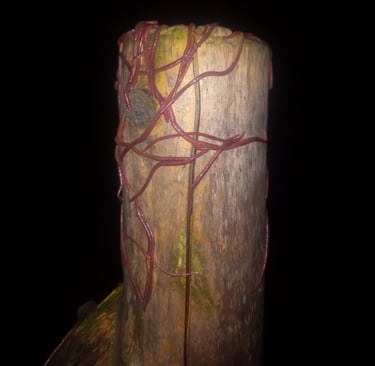

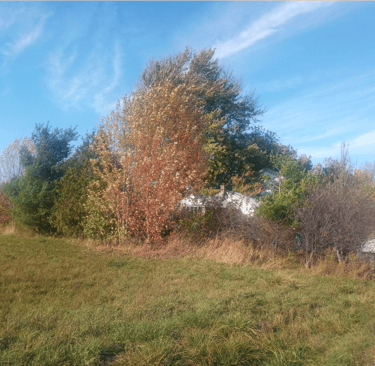
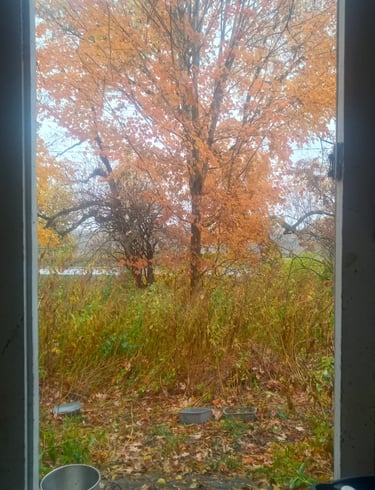


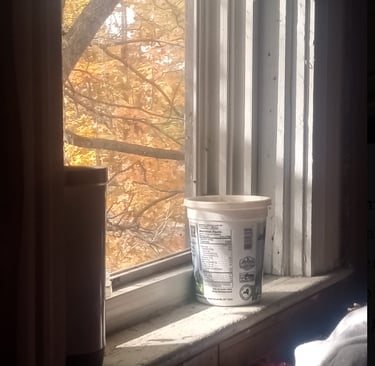
Earthworms climb a cedar fencepost during a rare rainstorm.
